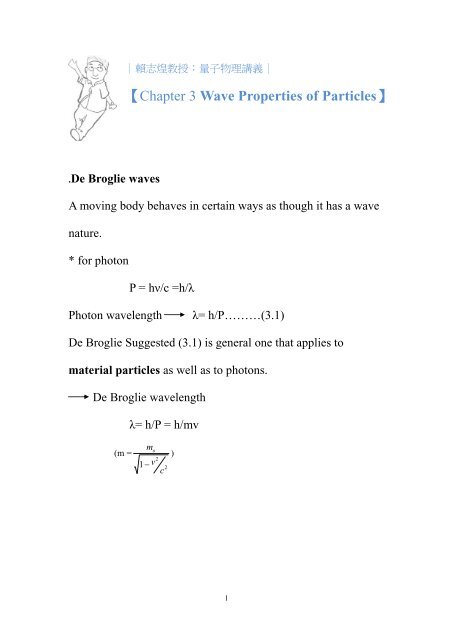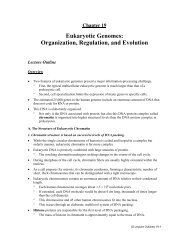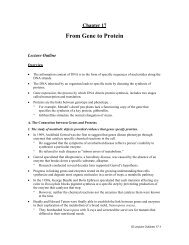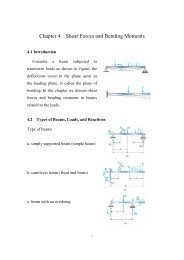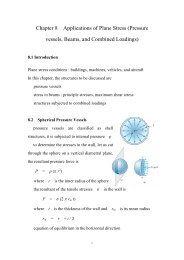for de Broglie waves
for de Broglie waves
for de Broglie waves
Create successful ePaper yourself
Turn your PDF publications into a flip-book with our unique Google optimized e-Paper software.
| 賴 志 煌 教 授 : 量 子 物 理 講 義 |<br />
【Chapter 3 Wave Properties of Particles】<br />
.De <strong>Broglie</strong> <strong>waves</strong><br />
A moving body behaves in certain ways as though it has a wave<br />
nature.<br />
* <strong>for</strong> photon<br />
P = hν/c =h/λ<br />
Photon wavelength<br />
λ= h/P………(3.1)<br />
De <strong>Broglie</strong> Suggested (3.1) is general one that applies to<br />
material particles as well as to photons.<br />
De <strong>Broglie</strong> wavelength<br />
λ= h/P = h/mv<br />
(m =<br />
m o<br />
2<br />
1<br />
v<br />
c<br />
2<br />
)<br />
1
Example 3.1<br />
Find the <strong>de</strong> Brogli wavelengths of<br />
(a) 46-g golf ball with a v = 30 m/s<br />
(b) e’ with a v = 10 7 m/s<br />
(1) v
【3.2 Waves of probability】<br />
Water wave<br />
Light wave<br />
(varing quantity) height of water surface<br />
E& H fields<br />
How about matter <strong>waves</strong><br />
Wave function Ψ<br />
The value of wave function associated with a moving body at<br />
the particular point x , y, z at time t is related to the likehood<br />
of finding the body there at the time.<br />
*Ψ has no direct physical significance<br />
0 probability 1<br />
but the amplitu<strong>de</strong> of wave am be positive or negative<br />
no negative probability<br />
2<br />
:squae of the absolute value of wave function<br />
probability <strong>de</strong>nsity<br />
** The probability of experimentally finding the body <strong>de</strong>scribed<br />
by the wave functionΨat the point x , y , z at time t is<br />
proportional to<br />
2<br />
there at t.<br />
wave functionΨthat <strong>de</strong>scribed a particle is spread out is spall,<br />
but it does not mean that the particle itself is spread out.<br />
3
【3.3 Describing a wave】<br />
<strong>de</strong> <strong>Broglie</strong> wave velocity v p<br />
v p =νλ(λ=h/mv)<br />
hν=mc 2 ν=mc 2 /h<br />
De <strong>Broglie</strong> phase velocity v p = νλ=(mc 2 /h)(h/mv)=c 2 /v (v =<br />
particle velocity)<br />
Because V
At x=0, y=Acos(2 t) <strong>for</strong> time=t<br />
Figure3.2<br />
Wave propagation.<br />
x = v p t , t =x/v p<br />
y=Acos2 t x/<br />
v )<br />
(<br />
p<br />
the amplitu<strong>de</strong> <strong>for</strong> y(x,t) = y(0,t-x/v p )<br />
v<br />
v<br />
x<br />
y = Acos2 ( vt ) v p = νλ<br />
y =Acos2 ( vt x/<br />
)<br />
p<br />
angular freguency ω= 2πν wave number k= 2π/λ=ω/v p<br />
y = Acos(ωt – kx)<br />
5
Figure3.3<br />
A wave group.<br />
Figure3.4<br />
Beats are produced by the superposition of two <strong>waves</strong> with different frequencies.<br />
6
The amplitu<strong>de</strong> of <strong>de</strong> <strong>Broglie</strong> <strong>waves</strong> →<br />
probability<br />
De <strong>Broglie</strong> wave can not be represented by<br />
y=Acos(wt-kx)<br />
. wave representation of a moving body → wave packet<br />
wave group<br />
. An example is a beat. (two sound <strong>waves</strong> of the same amplitu<strong>de</strong><br />
but slightly different frequencies)<br />
original 440, 442 Hz<br />
hear fluctuating sound of 441 Hz with<br />
2 beats/s<br />
Figure3.5 The Davisson-Germer experiment.<br />
a wave group: superposition of individual <strong>waves</strong> of different λ<br />
which interference with one another<br />
variation in amplitu<strong>de</strong><br />
<strong>de</strong>fine the group shape<br />
7
(1) If the velocities of the <strong>waves</strong> are the same the velocity<br />
of wave group is common phase velocity<br />
(1) If the phase velocity varies with λ<br />
an effect called dispertion<br />
individual <strong>waves</strong> do not proceed together<br />
wave group has a velocity different from the phase<br />
velocities<br />
the case of <strong>de</strong> <strong>Broglie</strong> wave<br />
• group velocity<br />
y 1 = Acos[(ωt –ks)]<br />
y 2 = Acos[(ω+Δω)t – (k+Δk)x]<br />
y =y 1 +y 2<br />
=2Acos1/2[(2ω+Δω)t –(2k+Δk)x]cos1/2(Δωt-Δkx)<br />
because Δω
& of wave number 1/2Δk<br />
Modulation produce wave group<br />
v p =<br />
2<br />
<br />
k 2 <br />
<br />
phase velocity<br />
v g =Δω/Δk = dω/dk group velocity<br />
<strong>for</strong> <strong>de</strong> <strong>Broglie</strong> <strong>waves</strong><br />
2mc<br />
2<br />
<br />
h<br />
2<br />
2<br />
2m oc<br />
<br />
2<br />
h 1<br />
v<br />
c<br />
(because hν=mc 2 )<br />
2<br />
2m<br />
k <br />
h<br />
h<br />
2m v<br />
o<br />
2<br />
1<br />
v<br />
c<br />
2<br />
2<br />
(because λ=h/mv)<br />
* both ω&k are functions of body’s v v g = dω/dk =<br />
d<br />
<br />
dv<br />
h<br />
2m v<br />
o<br />
2<br />
2<br />
1<br />
v 3 2<br />
c<br />
,<br />
dk<br />
dv<br />
h<br />
2m<br />
3<br />
2<br />
1<br />
v 2 2<br />
v g = v (<strong>de</strong> <strong>Broglie</strong> group velocity)<br />
<br />
o<br />
c<br />
d<br />
dv<br />
dk<br />
dv<br />
De <strong>Broglie</strong> wave group associated with a moving body travels<br />
with the same velocity as the body.<br />
De <strong>Broglie</strong> phase velocity v p =ω/k=c 2 /v<br />
v p > velocity of the body v > c<br />
(∵ it is not the motion of the body)<br />
9
Ex 3.3 :<br />
An e' has a <strong>de</strong> <strong>Broglie</strong> wavelength of 2pm=2x10 -12 m.Find its<br />
kinetic energy & the phase & group velocity of its <strong>de</strong> <strong>Broglie</strong><br />
<strong>waves</strong>.<br />
2 2 2<br />
(a) E =E o +kE kE =E – E o = Eo<br />
p c Eo<br />
pc = hc/λ= (4.136x10 -15 ev.s)(3x10 8 m/s)/(2x10 -12 ) =<br />
6.2x10 5 ev=620kv<br />
the rest energy of e' is E o =511kv<br />
2<br />
2<br />
kE= 511 620 511 292 kev<br />
(b) e' velocity<br />
2<br />
Eo<br />
E <br />
E<br />
v c 1<br />
o<br />
2 0. 771c<br />
2<br />
1<br />
v<br />
E<br />
2<br />
c<br />
∴ v p = c 2 /v =1.3c , v g = v = 0.771c<br />
10
3.5 particle diffraction e'-beam diffraction<br />
confirm <strong>de</strong> <strong>Broglie</strong> <strong>waves</strong><br />
Figure3.6 Results of the Davisson-Germer experiment.<br />
The method of plotting is such that the intensity at any angle is<br />
propotional to the distance of the curve at the angle from the<br />
point of scattering.<br />
Figure3.7 The diffraction of the <strong>de</strong> <strong>Broglie</strong> <strong>waves</strong> by the target responsible<br />
<strong>for</strong> the results of Davisson and Germer.<br />
11
nλ=2dsinθ<br />
λ=2dsinθ=0.165nm λ=h/mv=0.166nm<br />
Figure3.8 Because the wavelengths of the fast electrons in an electron microscope are shorter than<br />
those of the light <strong>waves</strong> in an optical microscope can produce sharp images at higher magnifications.<br />
The electron beam in an electron microscope is focused by magnetic fields.<br />
Figure3.9 A particle confined to a box of width L.<br />
12
【3.6 particle in a box】<br />
a prticle trapped in a box = a standing<br />
wave.<br />
Ψmust be zero at the walls<br />
λ n =2L/n n=1,2,3……<br />
De <strong>Broglie</strong> wavelength of trapped<br />
particles.<br />
Figure3.10<br />
Wave functions of a particle trapped in a box L wi<strong>de</strong>.<br />
KE=1/2(mv 2 )=(mv) 2 /2m=h 2 /(λ 2 2m)<br />
∵λ n =2L/n<br />
KE+v=E n the energy <strong>for</strong><br />
13
the particle in a box<br />
E n =n 2 h 2 /8mL 2 →n=1,2,3……..<br />
Each permitted energy is called an<br />
energy level.(n=quantum number)<br />
This can be applied to any particle confined to a certain region<br />
of space.<br />
Figure3.11<br />
Energy levels of an electron confined to a box 0.1nm wi<strong>de</strong>.<br />
14
For example<br />
e -<br />
nucleus<br />
1. Atraped particle cannot have an arbitrary energy, as a free<br />
particle can .<br />
Confinement leads to restriction on its wave function that alloy<br />
the particle to have certain energies.<br />
2. A trapped particle cannot have zero energy.<br />
∵ <strong>de</strong> <strong>Broglie</strong> wavelength λ=h/mv If v =0 λ=∞<br />
it can not be a trapped particle.<br />
3. ∵ h =6.63x10 -34 Js very small<br />
∴ only if m & L are very small, or we are not aware of<br />
energy quantization in our own experience.<br />
Ex 3.4<br />
An e' is in a box 0.1nm across, which is the or<strong>de</strong>r of magnitu<strong>de</strong><br />
of atomic distance, find its permitted energy.<br />
m=9.1x10 -31 kg &<br />
L=0.1nm=10 -10 m<br />
15
E n =n 2 (6.63x10 -34 )/8x(9.1x10 -31 )(10 -10 ) 2 =6x10 -18 n 2 J=38n 2 ev<br />
When n=1<br />
38 ev<br />
n=2 152ev see fig 3.11<br />
n=3 342 ev<br />
Ex 3.5<br />
A long marble is in a box 10 cm across, find its permitted<br />
energies<br />
E n = 5.5x10 -64 n 2 J n=1 E=5.5x10 -64 J v=3.3x10 -31<br />
m/s<br />
Which can not be experimentally distinguished from a stationary<br />
marble.<br />
For a reasonable speed 1/3 m/s n=10 30 !!<br />
Energy levels are very close<br />
quantum effects are<br />
imperceptible<br />
16
• Uncertainty principle<br />
* wave group narrower particles<br />
position precise.<br />
However, λof <strong>waves</strong> in a narrow packet is<br />
not well <strong>de</strong>fined<br />
∵λ=h/mv ∴ P is not<br />
precise<br />
* A wi<strong>de</strong> wave group clearly<br />
<strong>de</strong>finedλ but position is not certain<br />
Figure3.12 (a) A narrow <strong>de</strong> <strong>Broglie</strong> wave group. The position of the particle can be precisely<br />
<strong>de</strong>termined, but the wavelength (and hence the particle’s momentum) cannot be established<br />
because there are not enough <strong>waves</strong> to measure accurately. (b) A wi<strong>de</strong> wave group. Now the<br />
wavelength can be precisely <strong>de</strong>termined but not the position of the particle.<br />
17
uncertainty principle:<br />
It is impossible to know both the exact position & exact<br />
momentum of an object at the same time.<br />
Figure3.13 An isolated wave group is the result of superposing an infinite number of <strong>waves</strong> with<br />
different wavelengths. The narrower the wave group, the greater the range of wavelengths involves. A<br />
narrow <strong>de</strong> <strong>Broglie</strong> wave group thus means a well-<strong>de</strong>fined position ( ) but a poorly <strong>de</strong>fined<br />
wavelength and a large uncertainty in the momentum of the particle the group represents. A wi<strong>de</strong><br />
wave group means a more precise momentum but a less precise position.<br />
An infinite # of wave trains with different frequencies wave<br />
numbers and amplitu<strong>de</strong> is required <strong>for</strong> an isolated group of<br />
arbitrary shape.<br />
<br />
<br />
0<br />
x<br />
gk<br />
cos kxdk Fourier integral<br />
g(k): amplitu<strong>de</strong> of the <strong>waves</strong> varying with k , furrier trans<strong>for</strong>m<br />
of φ(x)<br />
Figure3.14 The wave functions and Fourier trans<strong>for</strong>ms <strong>for</strong> (a) a pulse, (b) a wave group, (c) an wave<br />
train, and (d) a gaussian distribution. A brief disturbance needs a broa<strong>de</strong>r range of frequencies to<br />
<strong>de</strong>scribe it than a disturbance of greater duration. The Fourier trans<strong>for</strong>m of a gaussian function is also a<br />
gaussian function.<br />
18
* wave numbers nee<strong>de</strong>d to represent a wave group extend from<br />
k=0 to k=∞, but <strong>for</strong> a group which length Δx is finite<br />
<strong>waves</strong> which amplitu<strong>de</strong>s g(k) are appreciable have wave number<br />
that lie within a finite interval Δk<br />
the shorter the group,<br />
the broa<strong>de</strong>r the range of wave numbers nee<strong>de</strong>d.<br />
Figure3.15 A gaussian distribution. The probability of finding a value of x is given by the gaussian<br />
function f(x). The mean value of x is x 0 , and the total width of the curve at half its maximum value is<br />
2.35σ, whereσis the standard <strong>de</strong>viation of the distribution. The total probability of finding a value of x<br />
within a standard <strong>de</strong>viation of x 0 is equal to the sha<strong>de</strong>d area and is 68.3 percent.<br />
*Gaussian function: f(x)=<br />
1<br />
2<br />
x<br />
x <br />
1 o<br />
2<br />
2<br />
e<br />
2<br />
n<br />
2<br />
x i<br />
x o<br />
n i<br />
1<br />
Standard <strong>de</strong>viation (square-root-mean)<br />
Width of a gaussian curve at half its max is 2.35σ<br />
o<br />
<br />
x<br />
p f dx 0 . 683<br />
x <br />
o<br />
x <br />
x <br />
o<br />
• Min ΔxΔk occur <strong>for</strong> Gaussian function<br />
Take Δx,Δk as standard <strong>de</strong>viation ofφ(x)& g(x)<br />
ΔxΔk=1/2∴<br />
in general ΔxΔk 1/2<br />
∵ k=2π/λ = 2πP/h P=hk/2π ΔP =hΔk/2π<br />
19
∵ΔxΔk 1/2<br />
Δk 1/2Δx<br />
ΔxΔp h/4π (∵Δx(hΔk/2π) h/4π)<br />
ΔxΔp 2<br />
<br />
[ =h/2π]<br />
Ex 3.6<br />
A measurement establishes the position of a proton with an<br />
accuracy of ± 1.00x10 -11 m. Find the uncertainty in the proton’s<br />
position 1.00s later. Assume v
look at e' light of wavelengthλ P=h/λ when one<br />
of three photons bounces off the e'<br />
e' momentum is<br />
changed.<br />
The exact P cannot be predicted, but ΔP~h/λ (the or<strong>de</strong>r of<br />
magnitu<strong>de</strong> as P)<br />
ie if we use shorterλ<br />
Δx~λ<br />
increase accuracy of position<br />
higher photon momentum disturb e' motion more<br />
accuracy of the momentum measurement <strong>de</strong>ceasing<br />
ΔxΔP≧ h (consist with ΔxΔP≧ /2)<br />
(1) If the energy is in the <strong>for</strong>m of em <strong>waves</strong>, the limited time<br />
available restricts the accuracy with which we can <strong>de</strong>termine<br />
the frequencyν.<br />
(2) Assume the min uncertainty in the number of <strong>waves</strong> we<br />
count in a wave group is one wave.<br />
∵Frequency of wave = # of wave/time interval<br />
Δν≧ 1/Δt<br />
∵E=hΔν ΔE≧ h/Δt or ΔEΔt≧ h<br />
more precise calculation ΔEΔt≧ /2<br />
21
ex 3.9<br />
An “excited” atom gives up its excess energy by emitting a<br />
photon of characteristic frequency. The average period that<br />
elapses between the excitation of an atom & the time it radiates<br />
is 1.0x10 -9 s. find the uncertainty in the frequency of the photon.<br />
ΔE≧ /2Δt=5.3x10 -27 J<br />
Δν=ΔE/h = 8x10 6 Hz<br />
22


